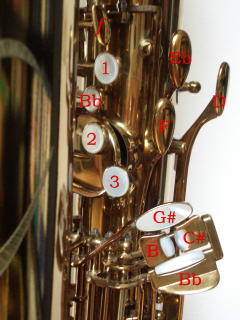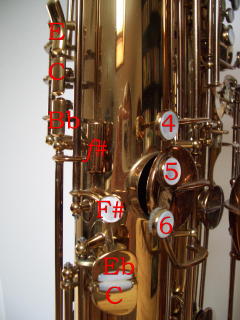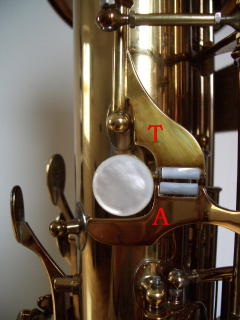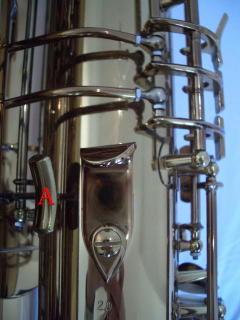Tubax altissimo fingerings
The following fingerings have proven most practical, but are by no means the only ones possible. Additionally, it's perfectly possible to play even higher, but here control becomes increasingly difficult since the harmonics are spaced more densely.
The sample Harlem Nocturne (2,7 MB) shows the entire range of the Tubax, from low bb0 upto ab4.
For mechanical reasons, keys 2 and 3 as well as 5 and 6 are linked, so the heavily used altissimo fork fingerings 1-3 etc. are not available on the Tubax. In compensation, there is the altissimo key A which provides totally new fingering options.
The rightmost column Harmonic tries to explain the fingering acoustically. Because of the conical bore of the saxophone, the harmonics are spaced wider than theoretically expected, namely the shorter the air column is, the wider are the harmonics spaced. For example, the third harmonic of c#2 is not g#3, but a3, a half tone higher. The third harmonic of eb2 is between bb3 and b3, thus not usable at all. For this reason, b3 is played as fourth harmonic of bb1. Not until the d4 can be fingered as a third harmonic, this time of f2, which is a whole tone higher than theory predicts.
The fingerings are written similar to The Woodwind Fingering Guide. Additionally, the note graphics have been taken from there.
| Note | Written | Fingering | Intonation | Remarks | Harmonic |
|---|---|---|---|---|---|
| e3 |  |
T EbD---|E--- | OK | standard side | 2nd of e |
| T f-23|--- | much too sharp | standard front, not usable | 3rd of g | ||
| f3 |  |
T EbD-F--|E--- | OK | standard side | 2nd of f |
| T f-2-|--- | OK | standard front | 3rd of a | ||
| f#3/gb3 |  |
T EbD-F--|Ef#--- | a bit sharp | standard side | 2nd of f# |
| T f-2-|f#--- | OK | standard front | 3rd of bb | ||
| g3 |  |
A 1--|--- | a bit flat | 3rd of b | |
| g#3/ab3 |  |
A -2-|--- | OK | 3rd of c | |
| A 1--|C--- | |||||
| a3 |  |
A ---|--- | OK | the easiest! | 3rd of c# |
| a#3/bb3 |  |
A D---|--- | a bit sharp | 3rd of d | |
| A 12-|--- | OK | 4th of a | |||
| b3 |  |
A Eb---|--- | too sharp | 3rd of eb | |
| A 1Bb--|--- | OK | 4th of bb | |||
| A 1--|4-- | |||||
| A 1--|-5- | |||||
| A 12-|Bb--- | |||||
| c4 |  |
A Eb---|E--- | much too sharp | not usable | 3rd of e |
| A 1--|(A)--- | a little sharp | second altissimo key optional | 4th of b | ||
| A Eb123|--- | OK | somewhat impractical | 5th of g | ||
| c#4/db4 |  |
A 123G#|E--- | OK | 5th of g# | |
| d4 |  |
A f---|C--- | OK | 3rd of f | |
| d#4/eb4 |  |
A f---|Cf#--- | a little sharp | 3rd of f# | |
| T ---|A--- | OK | 4th of c# | |||
| e4 |  |
T D---|A--- | OK | second altissimo required | 4th of d |
| f4 |  |
T EbD---|A--- | OK | second altissimo required | 4th of eb |
| f#4/gb4 |  |
(T)EbD---|AE--- | OK | octave key optional | 4th of e |
| g4 |  |
---|AE--- | OK | 5th of c# | |
| g#4/ab4 |  |
---|AEf#--- | a little sharp | 4th of f# |



